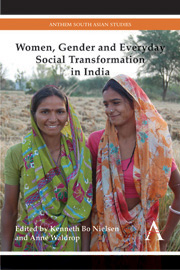Book contents
- Frontmatter
- Contents
- Acknowledgments
- Women and Gender in a Changing India
- PART I WORK, TECHNOLOGY, ASPIRATIONS
- Chapter One Today's ‘Good Girl’: the Women Behind India's BPO Industry
- Chapter Two Gender, Intersectionality and Smartphones in Rural West Bengal
- Chapter Three The Introduction of Electricity in the Sundarban Islands: Conserving or Transforming Gender Relations?
- Chapter Four Changing Consumption and the Negotiation of Gender Roles in Kerala
- Chapter Five Gender, Work and Social Change: Return Migration to Kerala
- Chapter Six Showtime and Exposures in New India: the Revelations of Lucky Farmhouse
- PART II DEMOCRACY AND THE DEVELOPMENTAL STATE
- PART III ASSERTIONS AND ACTIVISM
- About the Editors and Contributors
Chapter Three - The Introduction of Electricity in the Sundarban Islands: Conserving or Transforming Gender Relations?
from PART I - WORK, TECHNOLOGY, ASPIRATIONS
Published online by Cambridge University Press: 05 October 2014
- Frontmatter
- Contents
- Acknowledgments
- Women and Gender in a Changing India
- PART I WORK, TECHNOLOGY, ASPIRATIONS
- Chapter One Today's ‘Good Girl’: the Women Behind India's BPO Industry
- Chapter Two Gender, Intersectionality and Smartphones in Rural West Bengal
- Chapter Three The Introduction of Electricity in the Sundarban Islands: Conserving or Transforming Gender Relations?
- Chapter Four Changing Consumption and the Negotiation of Gender Roles in Kerala
- Chapter Five Gender, Work and Social Change: Return Migration to Kerala
- Chapter Six Showtime and Exposures in New India: the Revelations of Lucky Farmhouse
- PART II DEMOCRACY AND THE DEVELOPMENTAL STATE
- PART III ASSERTIONS AND ACTIVISM
- About the Editors and Contributors
Summary
In my opinion power and energy is business. You know, there is no social thinking … no emotion that women should be involved. It is business … it could be women based, it could be male based, you know, no problem, but it will be … energy business. (Dr S. P. Gon Chaudhuri, former director of the West Bengal Renewable Energy Development Agency (WBREDA), interviewed in Kolkata on 14 February 2010 by the Solar Transitions team)
In 1996, Dr S. P. Gon Chaudhuri and WBREDA initiated the Sundarban solar electricity project. Since then, a range of families in the Indian part of the Sundarban Islands have gained access to electricity for the very first time through the construction of 17 solar photovoltaic (PV) power plants and adhering minigrids. The case has been described as an example of best practice in terms of the high degree of revenue collection and customer compliance in the first years following implementation (Chakrabarti and Chakrabarti 2002; Gulati and Rao 2007; Shrank 2008; Ulsrud et al. 2011; Winther 2012). One important reason for the project's success was the inclusion of local people in the process. Technical functionality and financial sustainability were the two main concerns when setting up and running these locally anchored systems of provision.
The aim of this chapter is to examine the apparently gender-neutral Sundarban case from a gender perspective. A social analysis of these solar electricity systems immediately reveals that it was men rather than women who were recruited into the electrification project. Women’s inclusion, what Dr S. P. Gon Chaudhuri associated with ‘social thinking’, did not form part of the project’s organization, even though women in the Sundarbans, as in the rural south in general (Clancy et al. 2011), are primarily responsible for dealing with household energy issues. Women were therefore implicitly considered as an important group of end users and beneficiaries of electrification (see also Barnes 2007).
- Type
- Chapter
- Information
- Women, Gender and Everyday Social Transformation in IndiaA Revisionary History, pp. 47 - 62Publisher: Anthem PressPrint publication year: 2014



